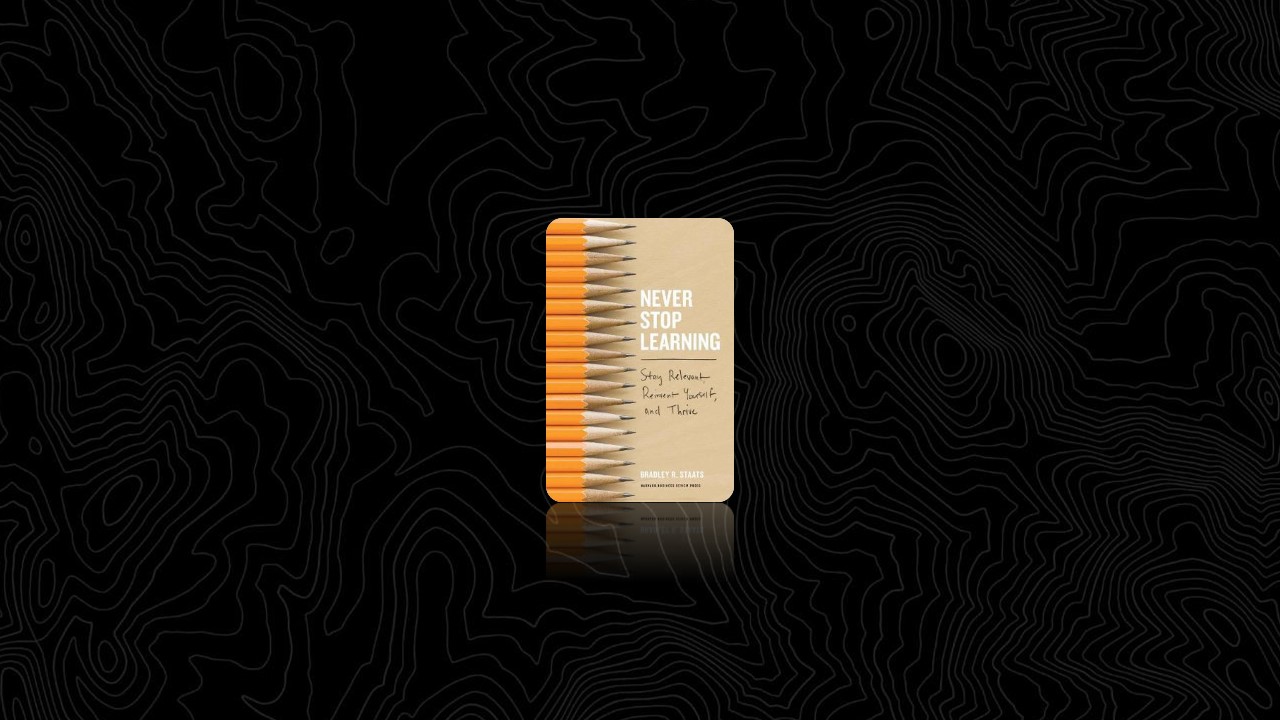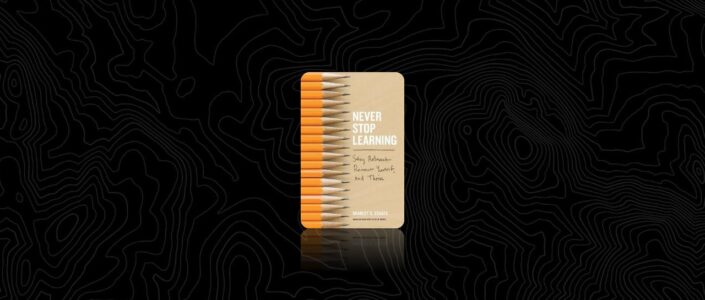Becoming a Dynamic Learner
Staying relevant in the learning economy requires dynamic learning. Dynamic learners both share knowledge broadly and use network effects (the value of services increases as more people use them: think Facebook). Failing to learn and adapt means being left behind. This creates meaningful risk for our organizations, ourselves, and our children. It’s not just knowledge that’s necessary—it’s using that knowledge to build more knowledge. In other words, to learn.
These key elements are necessary to becoming a dynamic learner:
Valuing failure—Dynamic learners are willing to fail in order to learn.
Process rather than outcome—Dynamic learners recognize that focusing on the outcome is misguided, because we don’t know how we got there, whereas a process focus frees us to learn.
Asking questions rather than rushing to answers—Dynamic learners recognize that “I don’t know” is a fair place to start—as long as we quickly follow with a question.
Reflection and relaxation—Dynamic learners fight the urge to act for the sake of acting and recognize that when the going gets tough, the tough are rested, take time to recharge, and stop to think.
Being yourself—Dynamic learners don’t try to conform; they’re willing to stand out.
Playing to strengths—Dynamic learners don’t try to fix irrelevant weaknesses; they play to their strengths.
Specialization and variety—Dynamic learners build a T-shaped portfolio of experiences—deep in one area (or more) and broad in others.
Learning from others—Dynamic learners recognize that learning is not a solo exercise.
Why Don’t We Learn from Failure?
Destigmatizing failure means shifting how you think about acting versus not acting. We are averse to loss, and failure always brings the possibility of loss. Instead of considering the safety of the status quo and the risk of doing things differently, consider the risk in the status quo and the safety that comes from learning new things. Identifying the uncertainties of not learning, along with the many gains to be made by trying new activities, is an absolute requirement.
Ed Catmull, the cofounder of Pixar, sums it up nicely in his book, Creativity, Inc., “Mistakes aren’t a necessary evil. They aren’t evil at all. They are an inevitable consequence of doing something new (and, as such, should be seen as valuable; without them, we’d have no originality).
Our focus on success is powerful but not insurmountable. To overcome it and learn from failure, you must begin by recognizing that failure is not typically as bad as you think it will be. Moreover, when you do fail, don’t let the learning opportunity escape by attributing the cause to outside events or denying that the failure even occurred. To learn, remember that “success consists of going from failure to failure without loss of enthusiasm.”
Learning Requires Process Focus, Not Outcome Focus
Process-focused learners can be found in many places. Taichi Ohno, the creator of the Toyota Production System, which transformed Toyota Motor Company from a post–World War II afterthought into one of the world’s largest and most consistently profitable automakers, is an example. Ohno knew that the system inside any organization was flawed, not because people didn’t work hard but because perfect understanding of a complex situation rarely exists—and even if it does, the outside environment will change and introduce new challenges. He once said, “Having no problems is the biggest problem of all.” Because all systems have flaws, seeking out those flaws and eliminating them is the only way to learn and improve.
Why is a process focus so central for learning? At its core, learning involves understanding what (and how) inputs affect important outputs—building a model of the way things work. Usually you need to accomplish some task—replace a knee with a prosthetic device, build a car, win a bicycle race—but to accomplish it, you need to understand the many pieces that contribute to the task and how they interact with one another. A process focus provides value on both fronts.
Asking Questions
Asking questions to learn is not something we need to be taught—at least not initially. Young children interact with the world 70 percent to 80 percent of the time with questions.
Scientific method—a basic approach to learning in all contexts—begins with a question. It helps us identify what our exploration is meant to answer. For example, Alexander Fleming was not searching for a way to prevent bacterial infections when he noticed something odd on a petri dish colonized by Staphylococcus bacteria.
However, when he saw that mold was growing on one dish and that no bacteria were in that area, he started asking questions. He didn’t know those questions would lead to the discovery of penicillin. When we ask questions, we fill in the blanks in our own knowledge.
We live in a world of answers. But if we want to get to answers that will increase our chances of being successful—both now and in the future—we need to recognize our tendency to skip asking questions, or to ask the wrong questions, and instead be willing to recognize that “I don’t know” is a fair place to start, and that we must quickly follow up by asking a question.
Being Yourself to Learn
Think about things you enjoy and try to incorporate them in your work and surroundings. Consider ways to inspire yourself. Research on happiness finds, for example, that doing things for someone else will give you more joy and satisfaction than doing things for yourself. People who were assigned to spend money on a gift for someone else were happier than people assigned to spend it on a gift for themselves.
Generating positive experiences doesn’t have to involve spending money, of course. You can express gratitude to someone who has helped you learn. Write a letter to a former teacher or mentor, or better yet, pick up the phone and call.
We think we need to fit in to our surroundings to succeed. But the opposite is true—at least up to a point. Others don’t look down on us when we allow our individuality to show. When we’re authentic, they respect it, and it positions us better to learn. Bob Sutton quotes Warren Bennis, the late, great management thinker who described the stifling nature of trying to be like everyone else: “The best you can be is a perfect imitation of those who came before you.”
Don’t fall prey to that fate. Instead, be yourself. You’ll be more positive, more motivated, and able to engage in more open learning.
Playing to Strengths, Not Fixating on Weaknesses
To learn from your strengths, you must first identify them. Doing this alone is challenging. But others can give you powerful insight into your own abilities. Fortunately, a tool can aid this process—the Reflected Best Self Exercise (RBSE). Originally developed by researchers at the University of Michigan, the RBSE is seemingly simple.
You identify ten to fifteen people who know you well. Part of the power comes from a diversity of feedback providers, so think broadly. Yes, you may include a manager or a coworker, but also include former colleagues, old friends, your college roommate, family members, a professor who mentored you, and others you think have unique insights into who you are when you’re at your best. Take time to identify your ideal choices—as with most things, the more up-front work you do, the more benefit you’ll see later on. The Center for Positive Organizations at Michigan, or a company such as Essentic, can run the process for you.
You identify ten to fifteen people who know you well. Part of the power comes from a diversity of feedback providers, so think broadly. Alternatively, you can do it yourself by reaching out to your feedback providers and asking them to identify two to three times when they saw you at your best and accomplishing things that were meaningful to them.
Learning from Others
You can improve your learning from others by changing how you interact. One of the challenges of collaboration is that we tend to exchange common information rather than unique information, thus limiting our ability to learn. More fundamentally, we often view interactions with others as a competition. For example, when people come together to discuss whom they should hire next or what product feature to include in the product road map, they think about the outcome as either a win or a loss. They take what has been described as an advocacy perspective.
By advocating their own take on a matter, they try to persuade others that they have the answer, instead of seeking more information about what is really going on. Rather than listening to evidence that might contradict their perspective, they attempt to dismiss anyone who sees things differently. This competitive view severely hampers learning.
We think of individual learning as involving just one person. But that approach is incomplete. Yes, each of us plays a key role in our own learning process, but so do others. We must understand that our learning often depends on others as much as or more than it depends on us. To overcome an inward focus, you need to build relationships, try to repeat your interactions, take an inquiry approach to working together, and teach others. By following that path, you can avoid wasting energy and spend it learning.


